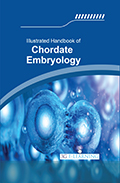Chordates are common in all major habitats.
Tunicate larvae either seek out a place where they can attach and metamorphose into an adult or develop into adults that float in the open water.
Cephalochordates develop in the open water, but as adults they lie partially or entirely buried in sand and gravel.
In either case, they are filter feeders with simple behaviour.
Up to date with the latest information on chordate embryology.
The book contains topics on cellular basis of development, DNA, RNA and protein synthesis, reproductive cycles, parthenogenesis and regeneration.





